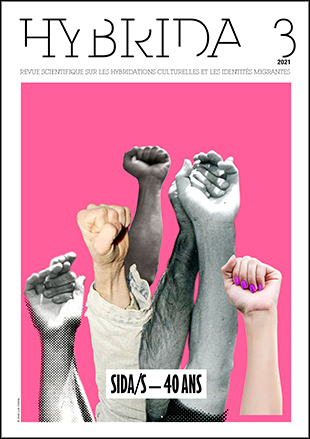The Eye-Opening Power of Creation : Images of AIDS and the Multifaceted Meanings of “Representation” in Robin Campillo’s BPM
DOI:
https://doi.org/10.7203/HYBRIDA.3.21528Keywords:
Campillo, AIDS, Act Up-Paris, representation, image Abstract
Abstract
Through the analysis of Robin Campillo’s film BPM (2017), this article seeks to analyze the role of images in our conceptualisation of the AIDS pandemic. By choosing to document a moment in France’s recent history that has been given little attention by cinema – namely Act Up-Paris’ activism during the 90s and its fight for social justice – the film endeavours to revisit the past through the lens of those individuals whose actions were instrumental in raising awareness of the state’s negligence in its handling of the pandemic. It is argued that by deciding to portray an organization whose public image was instrumental in its fight against the status quo surrounding AIDS, the film’s visual regimen rests on a mise-en-abyme of the concept of “representation” that allows the viewer to reflect on the way images can shape our understanding of social phenomena. We will more particularly focus on the relationship between images, memory, and knowledge. A semiotic analysis of the film image will enable us to highlight the constant dialogue the film establishes between the medium itself (i.e. the film image and the various elements that participate in its creation) and its subject matter. We will observe how Campillo creates images whose meaning is twofold: they shed light on the convergence of individual and community concerns that sustained the various public actions undertaken by Act Up-Paris, and how the latter perceived images as a disruptive force designed to unsettle the status quo surrounding the AIDS epidemic. By choosing to represent individuals whose involvement was instrumental in transforming people’s perception of AIDS but who have long remained invisible, the director also intends to create images that will enrich and deepen our knowledge of a recent yet little-known period of modern history.
 Downloads
Downloads
 References
References
Alion, Y. (2017, 28 août). Entretien avec Robin Campillo pour 120 battements par minute. L’Avant-scène cinéma. http://www.avantscenecinema.com/entretien-robin-campillo-120-battements-par-minute/
Blanchot, M. (1955). L’Espace littéraire. Gallimard.
Broqua, C. (2005) Agir pour ne pas mourir ! Act Up, les homosexuels et le sida. Presses de Sciences Po, coll. Académique.
Broqua, C. (2009). L’ethnographie comme engagement : enquêter en terrain militant. Genèses, 75, 109-124. https://doi.org/10.3917/gen.075.0109
Broqua, C. & Pinell, P. (2002). Avant-Garde. In P. Pinell (éd.), Une Épidémie politique. La Lutte contre le sida en France (1981-1996) (pp. 207–260). Presses Universitaires de France. https://doi.org/10.3917/puf.comit.2002.01.0207
Brugère, F. (2017). L’Éthique du « care ». Presses Universitaires de France, coll. Que sais-je?
Buton, F. (2005). Sida et politique : saisir les formes de la lutte. Revue française de science politique, 55, 787-810. https://doi.org/10.3917/rfsp.555.0787
Campillo, R. (Réalisateur). (2017) 120 battements par minute [Film]. Les Films de Pierre.
Caron, D. (2001). AIDS in French Culture : Social Ills, Literary Cures. University of Wisconsin Press.
Chémery, V., Farjat, J., Gérard, S., Lalande, A., Vermeersch, L. et Wahnich, S. (2018). Mémoire vive. Politique et sida dans « 120 Battements par minute »: Entretien avec Philippe Mangeot. Vacarme, 82, 104–115. https://doi.org/10.3917/vaca.082.0104
de Montigny, P. et Wallon, V. (2017, 12 septembre). Lutte contre le sida : un combat oublié ? Radio-Canada. https://ici.radio-canada.ca/nouvelle/1055390/lutte-sida-film-120-battements-minute
de Semlyen, P. (2018, 4 avril). I even tried using Grindr to cast the film : Robin Campillo talks 120 Beats per Minute. Timeout. https://www.timeout.com/london/film/i-even-tried-using-grindr-to-cast-the-film-robin-campillo-talks-120-beats-per-minute
Ernst, C. E. (1997). Activisme à l’américaine? The Case of Act Up-Paris. French Politics and Society, 15(4), 22–31. http://www.jstor.org/stable/42844674
Fleckinger, H. (2007). Militantismes homosexuels et cinéma : l’esthétique comme politique. In B. Perreau (dir.), Le Choix de l’homosexualité. Recherches inédites sur la question gay et lesbienne (pp. 133–150). EPEL.
Friedmann, D. (2013). Sociologie filmique, sociologie visuelle et écrit. In D. Vander Gucht La Sociologie par l’image : actes du colloque de sociologie visuelle, Bruxelles, 28-29 octobre 2010 (pp. 90–103). Revue de l’Institut de l’Université de Bruxelles.
Gilman, S. (1988). Disease and Representation : Images of Illness from Madness to Aids. Cornell University Press.
Hall, S. (1982). The Discovery of ‘Ideology’: Return of the Repressed in Media Studies. In T. Bennet, J. Curran, M. Gurevitch et J. Wollacott (éds.), Culture, Society, and the Media (pp. 56–90). Routledge.
Hart, K.-P. (2000). The AIDS Movie. Representing a Pandemic in Film and Television. Routledge.
Joly, M. (2004). Introduction à l’analyse de l’image. Armand Colin.
Kaes, A. (1989). From Hitler to Heimat : The Return of History as Film. Harvard University Press.
Kilbourn, R. J. A. (2010). Cinema, Memory, Modernity. The Representation of Memory from the Art Film to Transnational Cinema. Routledge.
Lestrade, D. (2000). Act Up : une histoire. Denoël.
Martel, F. (1996). Le Rose et le noir. Les Homosexuels en France depuis 1968. Seuil.
Nakayama, T. K. (2012). Act Up-Paris : French Lessons. Quarterly Journal of Speech, 98(1), 103–108. https://doi.org/10.1080/00335630.2011.638663
Patouillard, V. (1998). Une Colère politique. L’Usage du corps dans une situation exceptionnelle : le ZAP d’Act-up Paris. Sociétés contemporaines, 31, 15–36. https://doi.org/10.3406/socco.1998.1769
Péron, D. (2017, 20 août). Robin Campillo : « Chaque action d’Act Up était déjà enrobée par la fiction ». Libération. https://www.liberation.fr/france/2017/08/20/robin-campillo-chaque-action-d-act-up-etait-deja-enrobee-par-la-fiction_1590949/
Reyre, F. (2017, 22 août). 120 battements par minute. Critikat. https://www.critikat.com/actualite-cine/critique/120-battements-minute-2/
Roth-Bettoni, D. (2017). Les Années sida à l’écran. ErosOnyx Éditions.
Simonnet, A., Schmitt, I., Sioul, M., et Strazel, N. (s.d.). Act Up Paris : la (re)construction d’un symbole de la lutte contre le sida. Salle 421. https://salle421.eu/2018/01/04/act-up-paris-la-reconstruction-dun-symbole-de-la-lutte-contre-le-sida/
Téchiné, A. (Réalisateur). (2007) Les Témoins [Film]. SBS Films, France 2 Cinéma.
Vander Gucht, D. (2017). Ce que regarder veut dire. Pour une sociologie visuelle. Les Impressions nouvelles, coll. Réflexions faites.
Downloads
Published
How to Cite
-
Abstract893
-
PDF (Français )380
Issue
Section
License
![]()
All the documents in the OJS platform are open access and property of their respective authors.
Authors publishing in the journal agree to the following terms:
- Authors keep the rights and guarantee HYBRIDA the right to be the first publication of the document, licensed under a Creative Commons license Attribution-NonCommercial-ShareAlike 4.0 International (CC BY-NC-SA 4.0) that allows others to share the work with an acknowledgement of authorship and publication in the journal.
- Authors are allowed and encouraged to spread their work (once published) through electronic means using personal or institutional websites (institutional open archives, personal websites or professional and academic networks profiles) once the text has been published.
















